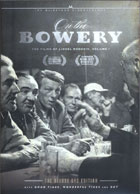
On The Bowery 1957
Distributed by Milestone Films & Video, PO Box 128, Harrington Park, NJ 07640-0128; 800-603-1104
Produced by Rogosin Films
Directed by Lionel Rogosin
DVD, b&w, 65 min.
Sr. High - General Adult
Film Studies, History, American Studies, Social Work, Sociology
Date Entered: 03/28/2012
Reviewed by Kim Stanton, University of North Texas LibrariesLionel Rogosin’s On the Bowery offers a sorrowful but fascinating look at residents of New York’s Bowery district during the late 1950’s. Originally an entertainment districts for the upper class, the Bowery fell into disrepute during the Civil War and became a haven for the downtrodden, the addicted and the homeless. Rogosin’s film focuses on Ray Sayler, an out of work railroad worker new to the Bowery. Initially a somewhat upbeat, promising character, Ray’s quick slide into destitute alcoholism unfolds as an allegorical drama, serving as a representation of the addiction and circumstances of the Bowery’s inhabitants as a whole. At the end of the film Ray seems resolved to escape the Bowery by train. As an acquaintance explains Ray’s absence to a group of barfly, one man replies “he’ll be back”. These are the last lines of the film and Ray’s fate is ultimately left unresolved.
A beautifully restored and moving film, On the Bowery is also notable for pioneering a new style of filmmaking. Rogosin found influence in both Robert Flaherty and the Italian neo-realism movement, resulting in an unabashed, realistic film that combined scripted and unscripted scenes and used non actors as characters. Documentary and narrative filmmakers alike have since been heavily influenced by Rogosin’s style, perhaps most notably John Cassavetes. Considered by the Academy to be a documentary, On the Bowery was nominated for a Best Documentary Feature Oscar in 1957.
The abundance of special features included with the DVD release are extremely helpful in contextualizing On the Bowery and Rogosin’s place is film history. Features includes an introduction by Martin Scorsese, a feature about the making of On the Bowery and several shorts that look at the Bowery from the 1930’s to present day.
On the Bowery is highly recommended for libraries with film studies collections. The film is relevant for studies in history, sociology, and social work making it appropriate for any general higher education collection.